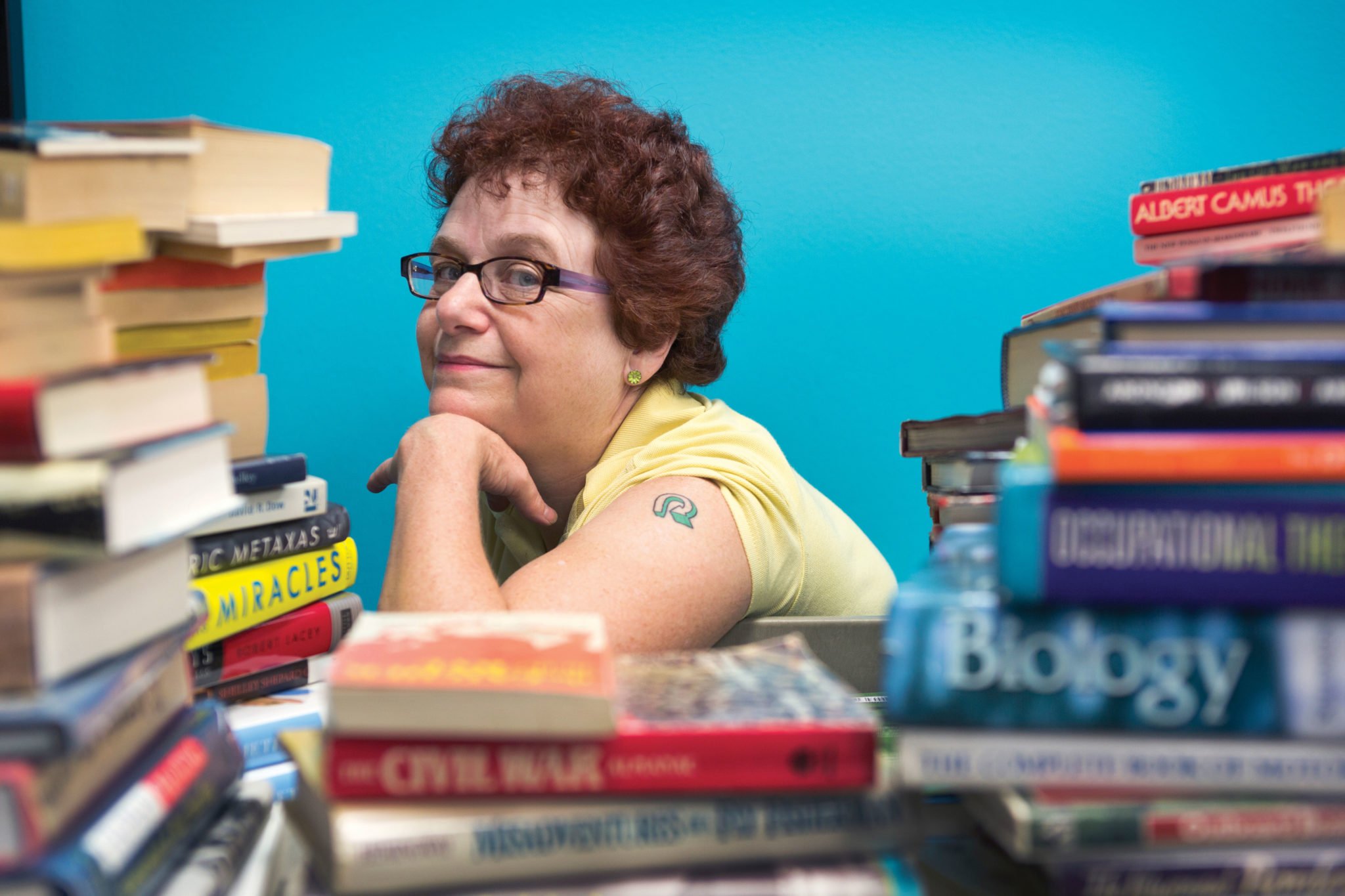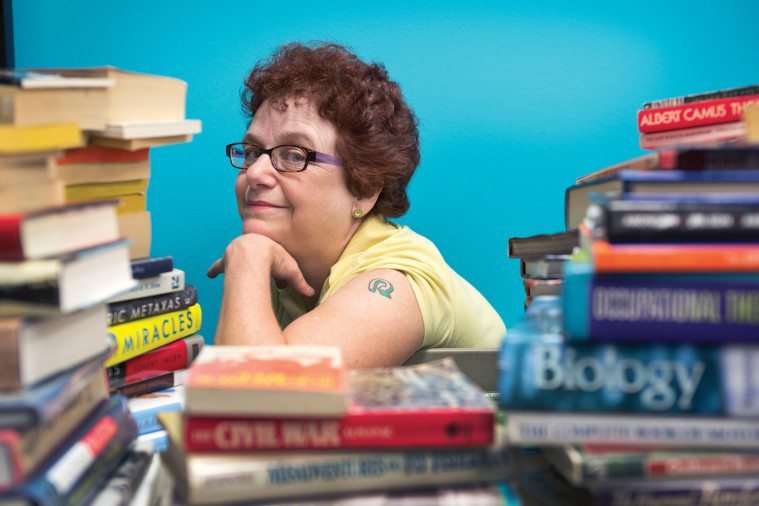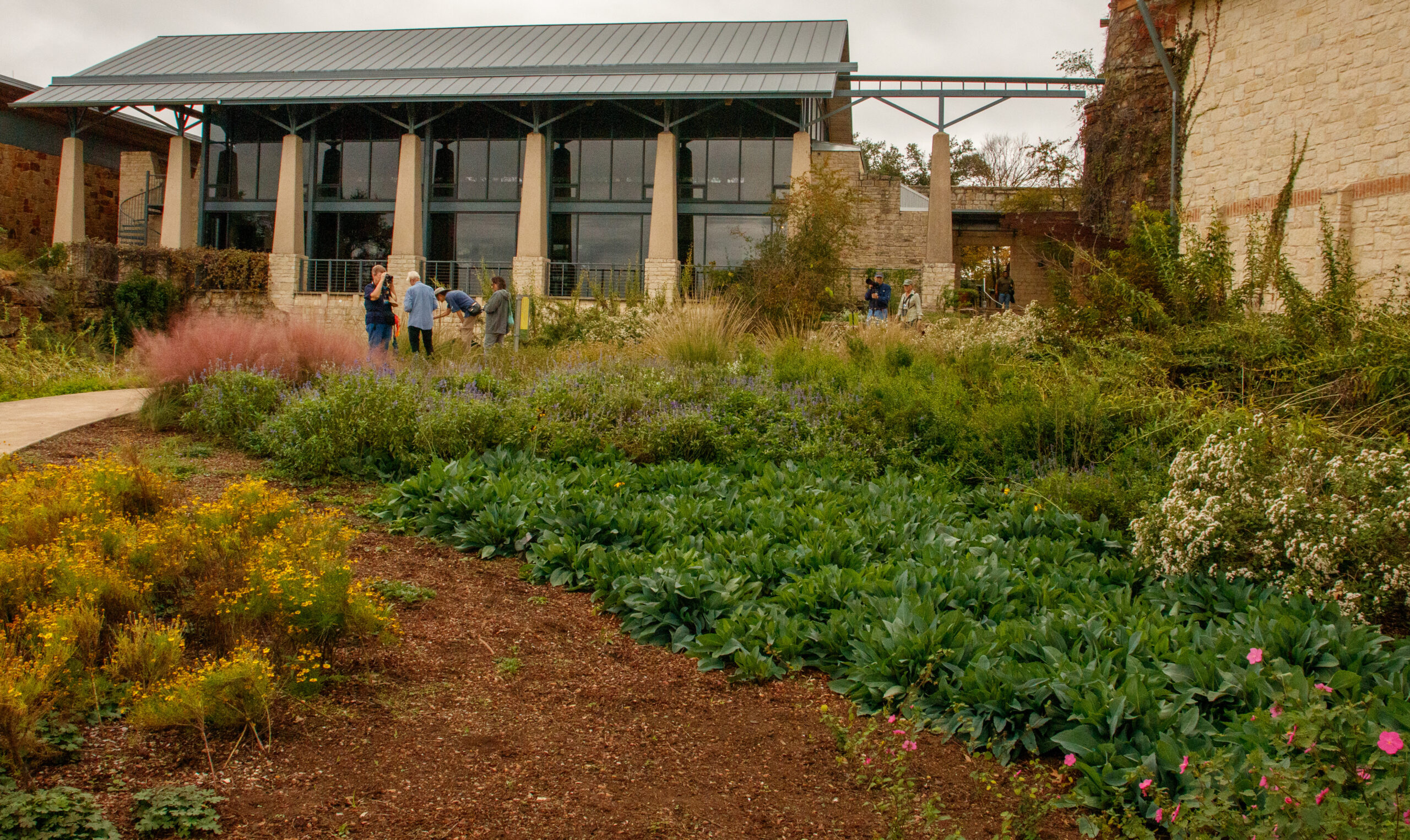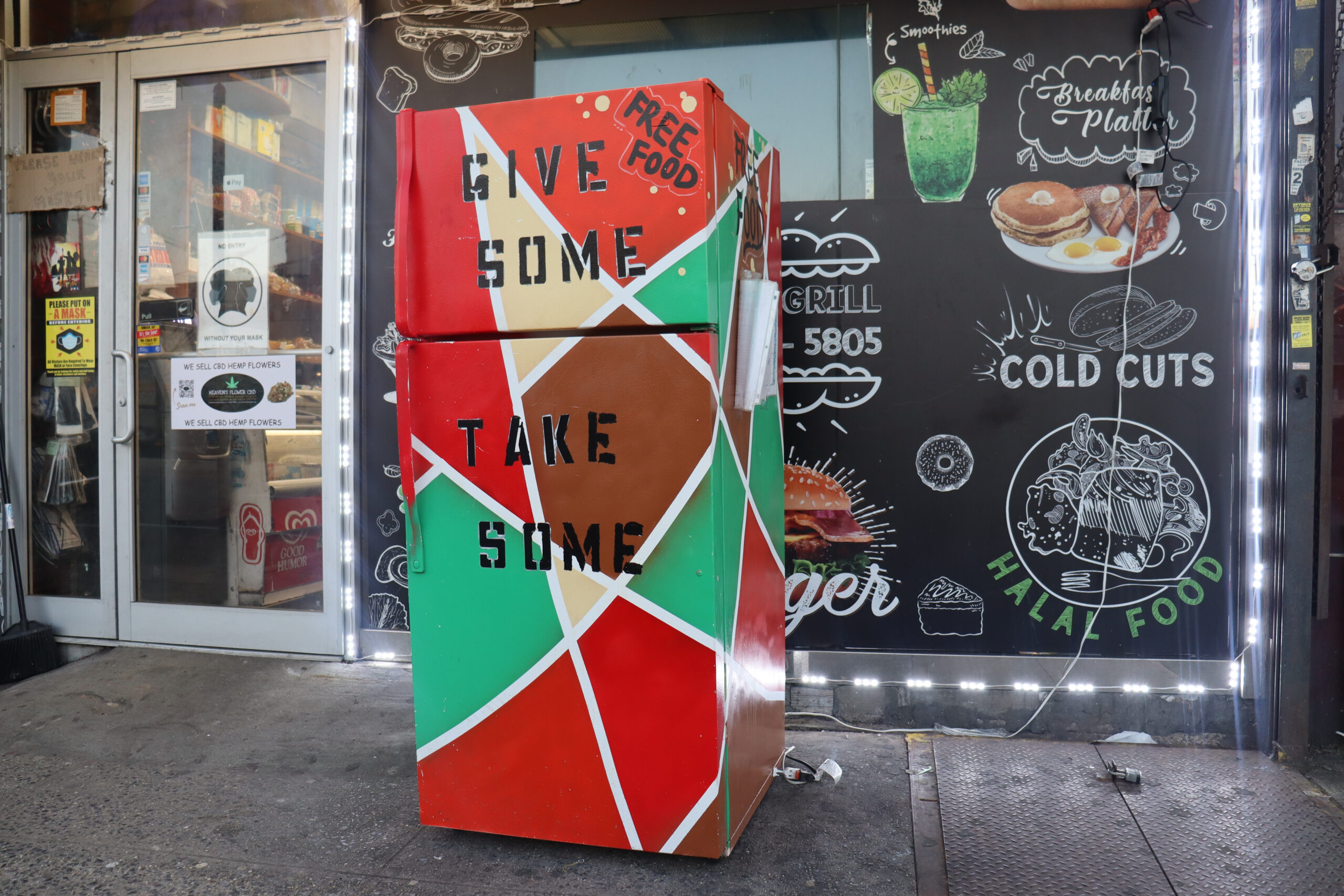
Finding a Cure for ‘The DaVinci Code Syndrome’
An Austin used-bookstore manager crusades for zero waste.
A version of this story ran in the October 2015 issue.

Perhaps you’ve unknowingly contributed to what used-bookstore managing librarian Mindy Reed calls “The Da Vinci Code syndrome.” Back in 2003, when the book came out, maybe you heard the buzz about the Dan Brown novel and tried to borrow it from the library. But since all the copies were checked out, you were put on the waiting list. A month later, after you’d moved from 250 to 150 on the list, you found yourself in an airport with nothing to read, so you gave in and bought the book. After your father moved into assisted living, you inherited his copy, too. When you cleaned out the garage, you hauled a box of books to Half Price Books, but with more than enough copies, the store declined yours. So you dropped it off at Recycled Reads — the used bookstore affiliated with the Austin Public Library system — and became part of Mindy Reed’s headache.
“To this day, a week doesn’t go by when we don’t get a couple copies donated to us,” says Reed, the aptly named manager of Recycled Reads. “For a while, you could fill up this whole space with The Da Vinci Code. How many of those can you sell or resell when everyone’s read it already?”
Not many, according to Reed, who has spent the last six years trying to develop a system for finding new homes and purposes for thousands of old copies of The Da Vinci Code, Tina Fey’s Bossypants, and Elizabeth Gilbert’s memoir Eat, Pray, Love. Opened in 2009, Recycled Reads processes 12 to 15 tons of materials a month — the equivalent of 70,000 bestsellers, textbooks and outdated encyclopedias. Although used bookstores affiliated with libraries are hardly unusual, Recycled Reads stands out for its emphasis on zero waste. The store sells as many books as it can, turns some of the rest into crafts, and partners with Goodwill and online reseller Thriftbooks to sell or recycle the leftovers.
The store is a sustainable destination not only for old library volumes but also for the castoffs of Austinites, many of whom likely have no inkling that the books they carefully place in single-stream recycling carts are not always recycled. Since hardback covers can clog recycling equipment and the glue in bindings degrades the quality of baled paper, books sent to be responsibly recycled may end up in landfills; it just takes too long to rip off their covers. Recycled Reads has developed a system for ensuring that every item from its deluge of books meets an environmentally friendly end.
Shifts in the publishing industry could also reduce waste, particularly if companies took advantage of digital technology to discriminate between books that should and should not be printed.
Over the years, Recycled Reads has prompted the Austin Public Library system to rethink its entire ordering process with sustainability in mind. The store also has earned national recognition: In 2013, it was awarded a grant from the Institute of Museum and Library Services (IMLS) to develop online training videos for other library systems hoping to start similar stores. In March, the industry publication Library Journal named Reed one of 50 “Movers and Shakers” because of her innovations at the store.
Still, for Reed, finding a green way to handle the byproduct of marketing frenzies that sell millions of copies of bestsellers requires looking beyond even recycling. “We set up this notion about this attachment we have to the container [of a book] because we all have such perfect memories of the first time we sat and read Winnie-the-Pooh or sitting on the floor and going through the World Book Encyclopedia to find what we want,” she says. “[But] the container that we call ‘the book’ has been co-opted by all this other content that doesn’t deserve that kind of admiration. I ask people, ‘Do you feel the same way about Snooki’s book that you do about Pride and Prejudice? Do you feel the same way about an American Idol biography that you feel about Man’s Search for Meaning?’ We need to really think about the book that we want to really hold close to us … versus other stuff that gets put in this container that could [be conveyed] in better, sustainable ways.”
Before Recycled Reads opened, the nonprofit Friends of the Austin Public Library sold donated books and materials withdrawn from the library collection at “monster book sales.” Whatever didn’t sell was set out on the sidewalk and marked “free.” But in 2007, a convergence of factors led Toni Lambert, assistant director for public services for the city library system, to take a new approach. She found a storefront among the consignment shops on Burnet Road, and hired Reed, a former head of purchasing and marketing in the tech industry and a second-career librarian, to manage the space as a used bookstore.
Over the years, Recycled Reads has prompted the Austin Public Library system to rethink its entire ordering process with sustainability in mind.
“At first I thought, ‘Oh, great, I’m going to be like Meg Ryan in You’ve Got Mail, Reed says. “She owns this little used bookstore, and it’s very charming.” Then Reed was deluged with unwanted books, giant boxes of them from the library’s 22 branches and donations from people downsizing, moving or cleaning out storage units. Pallets of books stacked up, floor to ceiling, in the store’s back room. “I realized very quickly that if we didn’t have a process for what to do with the books we couldn’t sell, this thing was going to grind to a halt in a matter of months,” Reed says. “Suddenly I’m shifting from the idea of a dusty retail bookstore to a reuse and repurposing center.”
She came up with a system of multiple channels for old books. When donations arrive at the store’s loading dock — sometimes at a rate of thousands of items per hour — they’re triaged in the back room. The most valuable volumes are culled and sold online at Ebay and Alibris if they’ll bring $15 or more. The rest of the salable stock — sheet music, vinyl records, VHS tapes, DVDs and maps as well as books — is stacked on the 5-foot metal shelves that line the blue-carpeted store. Hardcovers sell for $2, paperbacks for $1, children’s books for 50 cents.
Some of the materials that don’t get sold become the raw supplies for craft projects. Recycled Reads hosts Upcycle This!, a free monthly craft workshop that invites people to turn the materials into sheet-music flowers, compact-disc flowerpots and desktop mailboxes made from the pages of old books.
The rest of Reed’s unsalable inventory is set aside for Goodwill Central Texas, which picks up 2 to 3 tons of materials every week, then sells them online or in its retail stores. If a copy of, say, a Twilight volume is collecting dust on a shelf, it may be transferred to the deeply discounted Goodwill outlet store, where clothes sell for $1.39 a pound and books are five for 99 cents. “We want to give everything every possible chance to continue its life as whatever product it is out in the community before we bring it into our recycling and salvage operation,” explains Kelly Freeman, director of sustainability for Goodwill Central Texas.
Books that don’t sell at the Goodwill outlet are shipped to Thriftbooks, a national online used-book dealer that boasts 7 million items in stock at any given time. Books that the dealer can’t sell or donate to charity are recycled into paper stock. Recycled Reads has started a pilot partnership with Thriftbooks, which pays the store 12 cents a pound for discarded materials. “We’re always looking downstream, because we’ve taken this responsibility that we don’t want anything to go into the landfill,” Reed says. “So we work with these other operations to make sure that if they take them, the next step is to reuse or recycle.”
Recycled Reads generates $11,000 to $12,000 in monthly sales, a considerable amount considering that all of its inventory is free. Recycled Reads also gets paid by the city government’s Austin Resource Recovery, based on the volume of materials the store diverts from the landfill. With the expenses of rent, utilities and four staff salaries, Recycled Reads hasn’t broken even yet, though Lambert, the library system’s assistant director, says that’s not her or the city’s primary concern.
More to the point, Reed’s system has been so effective it’s become high profile in the quiet world of used bookstores, library systems and the people who work in both. The 2013 grant from IMLS recognized the store’s pioneering zero-waste approach and its emphasis on the entire life cycle of library books. IMLS Senior Program Officer Sandy Toro said that while many libraries have bookstores, few have physical spaces focused on recycling, and Recycled Reads may be the only one that partners with Goodwill. “Something else that struck me is the sheer tonnage,” Toro says. “Since 2009, they’ve saved more than a thousand tons of materials from going into the landfill.”
As part of the grant, Recycled Reads surveyed librarians across the country about how they dispose of materials withdrawn from a library collection because of their age or condition. Only one-third of respondents said their libraries considered “end of life” for books at the time they were purchased. Almost 40 percent said that at least some weeded books were put in library dumpsters. “The field is lacking a general awareness of what needs to happen at the end of the life of a book,” Toro says. “I think that’s something that this project brought to light.”
The entrepreneurial spirit and negotiating skills that Reed honed during her tech-industry career helped get Recycled Reads off the ground.
The entrepreneurial spirit and negotiating skills that Reed honed during her tech-industry career helped get Recycled Reads off the ground. Six years in the trenches of the used-book world have given her an unsentimental practicality not often associated with librarians and their collections. “Books are like lettuce — they have a shelf life,” she tells colleagues reluctant to get rid of outdated materials.
“Take paperback romances. Romance readers are voracious readers, but very few reread copies of a book, so the pipeline of those never ends. We’ve had people come in with boxes and boxes of them when, for instance, they clean out their mother’s house when she moves to assisted living. All of a sudden we have every Harlequin romance that was ever published from 1987 to 2008. There’s just not a market to resell those.”
Any solution to the glut of materials, she says, involves looking at the “whole ecosystem” of book production and consumption, “upstream” as well as “downstream.” While libraries have sustainability built into their mission — multiple people reuse copies of the same book — the ordering process for new materials isn’t always green. In the IMLS training videos that Reed narrates, she urges librarians to consider the entire life cycle of books when they purchase them. How long will the book be used? What will happen when the enthusiasm for a particular bestseller inevitably wanes? Such considerations have become de rigueur in Austin; two years ago, the library system changed its acquisitions policy to reduce the number of copies of popular books it orders and instead encourages branches to share those volumes.
Shifts in the publishing industry could also reduce waste, particularly if companies took advantage of digital technology to discriminate between books that should and should not be printed. “Think about if publishers would encourage books like Fifty Shades of Grey to be digital,” Reed suggests. “Put all the digital content out that you want, eat it like candy, let it satiate you and then go away. Then [we can choose] the things that really deserve to be in this container that we are going to keep as an artifact as well as a purveyor of content.”
It sounds a bit provocative: Some works deserve to be in physical vessels while lesser writing should be consigned to digital transience. Who wants to get into the business of deciding which is which? But Reed says consumers already are making the distinction, and that’s clear from the boxes of Twilight and The Hunger Games that she and her staff unpack every day. “I might enjoy reading these books, but I’m not necessarily going to want to hold onto them,” she says. “And from what we’re seeing here, other people don’t want to hold onto them either.”
Publishers could offer new releases as e-books first, then see if there’s enough interest to make paperbacks and hardcovers. And print-on-demand technology, already adopted by self-published authors, may be part of the solution.
“One of the things I’m very conscious about before I make any purchase is the packaging, because I don’t want to create extra waste,” Reed says. “This is about building a consciousness and starting a discussion.”


